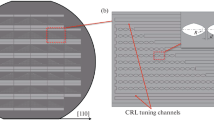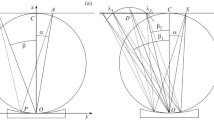Abstract—
An optical scheme is described for a compact focal monochromator with a plano-convex magnesium-fluoride lens for measuring and analyzing transmission spectra of transparent objects in the vacuum ultraviolet spectral range within air transparency bands in the 113—140 nm spectral range. Short distances between the source and detector in the range from 5 to 40 mm allow operation in air, using the presence of bands of mutual partial transmittance of oxygen and water vapor at wavelengths of 114.2, 116.4, 118.5, 121.2, 123.5, and 127.0 nm. Simulated absorption spectra of air spaces of different lengths are presented in the spectral range of interest. Deuterium lamp emission spectra are experimentally measured in the 113–140 nm spectral range after passing through air gaps of different lengths. The monochromator spectral resolution reaching 50 near the magnesium fluoride absorption edge is defined by the joint contribution of the lens dispersion and radiation filtering in the air spectral transmittance bands.
Similar content being viewed by others
Avoid common mistakes on your manuscript.
1 INTRODUCTION
Various monochromators [1] are widely used in physical and biological experiments. Dispersing elements of monochromators in vacuum ultraviolet (VUV) and soft X-ray spectral ranges, including that when using in air, are prisms [2], diffraction gratings [3], including those with non-equidistant grooves [4], and combinations of prisms and gratings [5].
In this paper, we describe the principles of operation of the focal monochromator with a single compact lens made of magnesium fluoride single crystal (the lens with the curvature radius of 2 and 1.4 mm axial thick was fabricated at the Lebedev Physical Institute by V.S. Maslov [6]). Such a device can be used in studies of VUV transmission spectra of polymers, track membranes, and organic films [7]; measurements can be performed not only in vacuum, but also in air under room conditions.
2 MONOCHROMATOR OPTICAL SCHEME
Focal monochromators are known still from the times of H. Rubens and R. Wood [8]; however, are used rarely at the present time. The focal monochromator (Fig. 1) consists of a focusing lens and a mobile diaphragm in front of the detector. Since the lens focal length depends on λ, diaphragm displacement allows efficient signal separation at certain wavelengths therewith measuring the spectrum. The focal monochromator efficiency increases with the lens material dispersion in the spectral range under consideration.
Schematic of the focal monochromator based on a single plano-convex lens. Radiation from source S is focused at various areas of the optical axis for various λ. Versions with both screen E and without it are possible. Displacement of the point diaphragm D allows separation of radiation with a certain wavelength.
In 1984, researchers of the Bell Laboratory (United States) T. Childs, W. Royer, and N. Smith described for the first time a simple focal VUV monochromator based on a lithium fluoride lens [9]. Their monochromator was intended for a spectral region with a photon energy near the LiF transmission cutoff (E < 11.7 eV, λ > 106 nm).
We propose a compact focal VUV monochromator with a compact plano-convex lens made of magnesium fluoride for operation in VUV transmission provides of air in the region of 113–140 nm where MgF2 features a stronger dispersion than LiF, which provides a higher resolution. Furthermore, magnesium fluoride is not so hygroscopic as LiF. Therefore, the use of a MgF2 lens and a decrease in the source—detector distance to 10–20 mm can allow measurements of sample characteristics, e.g., the thin-film filter transparency not only in a vacuum chamber, but also in air under room conditions in atmospheric windows [10].
3 SIMULATION AND EXPERIMENTAL RESULTS
Main absorbing agents in VUV in air are molecular oxygen and H2O vapor. Figure 2 shows the spectra of absorbances of (a) oxygen molecules and (b) water vapor in the range of 113–130 nm, as well as numerically simulated emission spectra of a hydrogen lamp in the range of 113–130 nm, subjected to absorption in an air gap of length L = 10 mm (c) and L = 40 mm (d) between the lamp and detector. The absorption spectra of oxygen molecules and water vapor in VUV were taken from [11, 12]. The initial emission spectrum of the hydrogen lamp for calculation was taken from [13].
The laboratory air parameters: atmospheric pressure p = 743 Torr, temperature +21°C, and relative humidity of 87% were used in calculations.
The coinciding transmission bands of oxygen and water vapor correspond to wavelengths of 114.2, 116.4, 118.5, 121.2, and 123.5 nm which is confirmed by the simulated spectra (c) and (d) in Fig. 2. We can see that radiation in weaker transmission bands (121.2, 123.5 nm, as well as in weak bands of 115.4 and 127.0 nm) gradually disappears as the source–detector distance increases from L = 10 mm to L = 40 mm, and remains only in the three strongest bands of 114.2, 116.4, 118.5 nm.
The spectral range of 113–140 nm is convenient for studies, since it contains strong emission lines of hydrogen and deuterium molecules [13–15]. In the experiment on detecting the effect of air absorption in gaps of different lengths b on the spectrum in the range of 113–140 nm, we used an LD-3 deuterium lamp with an MgF2 output window and a TVM-8 double-grating vacuum monochromator with a spectral resolution of 0.8 nm (Fig. 3). The TVM-8 monochromator is based on the double Johnson–Onaka configuration with dispersion subtraction; the detector is a solar-blind FEU-142 photomultiplier.
(a) Schematic diagram of the focal monochromator with a compact MgF2 lens (external view on the inset) and a mobile diaphragm. (b) Experiment on the detection of the effect of air absorption in the gap b on the spectrum of an LD-3 deuterium lamp (source S) using the double-grating TVM-8 monochromator. (c) The spectra measured in the range of 113–140 nm in the scheme (b) at various gaps b. Spectrum (3) is shown in actual size, spectra (1) and (2) are demagnified by factors of 27 and 4, respectively; spectra (4) and (5) are magnified by factors of 2 and 4, respectively.
The measurement results shown in Fig. 3c exhibit radiation attenuation in relatively weak air transmission bands (115.4, 121.2, 123.5, and 127.0 nm) with increasing the air gap b from 1.5 mm to 20 mm. Only in transmission bands of 116.4 nm and 118.5 nm, relatively strong emission lines at b = 20 mm remain. Due to the strong absorbance of the deuterium lamp window material, there are no emission lines in the transmission band of 114.2 nm, and the intensity in the band of 116.4 nm appears lower than in the band of 118.5 nm (compare Fig. 3c for deuterium and Fig. 2d for hydrogen lamps).
Figure 4 shows the calculations of the spectra which will be measured using the focal monochromator with the lens—detector distance d = 20 mm, when moving diaphragm D in Fig. 1 in two cases: in the absence of the screen E which blocks paraxial beams and in its presence. A diaphragm diameter in the calculations was taken as 5 μm; the diaphragm position is measured from the flat lens surface. A deuterium lamp was taken as a source; calculations were performed taking into account the absorbance of the MgF2 lens material [16]. In the used scheme, the monochromator resolution at a wavelength of 116.4 nm is R ≈ 55. We note that magnesium fluoride features birefringence; however, this is not noticeable at R < 100.
Numerically simulated spectra recorded with the detector in the focal monochromator scheme (a) in the absence of screen E in Fig. 1 and (b) in the presence of screen E having 2 mm in diameter, closing paraxial beams. The spectra are calculated for the case of a deuterium lamp situated at the lens—detector distance d = 20 mm.
4 CONCLUSIONS
The focal monochromator based on a single plano-convex spherical MgF2 lens for operation in air in the near VUV spectral range near the MgF2 transmission cutoff (in the range of 113–140 nm) is proposed. At comparatively small distances from the source output window (deuterium or hydrogen lamp with magnesium fluorine windows [14, 15]) to the radiation detector from 2 mm to 20–40 mm, the signal at certain wavelengths in the regions of simultaneous transmission of oxygen and water vapor molecules (114.2, 116.4, 118.5, 121.2, and 123.5 nm) appears sufficiently intense for detection and further analysis.
The described compact focal monochromator with a mobile point diaphragm can be used for rapid analysis of transmission spectra of thin films, filters, and other samples in air with a moderate spectral resolution of ~50.
REFERENCES
Toporets, A.S., Monochromators, Usp. Fiz. Nauk, 1950, vol. 40, no. 2, pp. 255–300. https://doi.org/10.3367/UFNr.0040.195002c.0255
Tur’yanskii, A.G., Konovalov, O.V., Gizha, S.S., and Beilin, N.D., Edge diffraction effect at the refraction of X-rays in a diamond prism, JETP Lett., 2014, vol. 100, no. 8, pp. 540–542. https://doi.org/10.1134/S0021364014200119
Kolesnikov, A.O., Vishnyakov, E.A., Ragozin, E.N., and Shatokhin, A.N., Imaging broadband soft X-ray transmission-grating spectrograph for a wavelength range λ > 111 Å, Quantum Electron., 2020, vol. 50, no. 10, pp. 967–975. https://doi.org/10.1134/S1063784220110109
Vishnyakov, E.A., Kolesnikov, A.O., Ragozin, E.N., and Shatokhin, A.N., Normal-incidence imaging spectrograph based on an aperiodic spherical grating for the vacuum spectral region, Opt. Spectrosc., 2018, vol. 125, no. 5, pp. 783–794. https://doi.org/10.1134/S0030400X18110346
Hashimoto, Sh., Ikeda, T., Takeuchi, H., and Harada, I., Utilization of a prism monochromator as a sharp-cut bandpass filter in ultraviolet Raman spectroscopy, Appl. Spectrosc., 1993, vol. 47, no. 8, pp. 1283–1285. https://doi.org/10.1366/0003702934067775
Maslov, V.S. and Mitrofanov, A.V., Levenguk microscope with magnesium fluoride lens for microscopic objects observation, in VUV, Proc. VI All-Russian Conference on VUV Physics and Interaction of Radiation with Matter, 1982, p. 236.
Mitrofanov, A.V., Tokarchuk, D.N., Gromova, T.I., Apel, P.Yu., and Didyk, A.Yu., Fabrication of metal microtubes using particle track membranes processing, Radiat. Meas., 1995, vol. 25, no. 1–4, pp. 733–734. https://doi.org/10.1016/1350-4487(95)00234-6
Rubens, H. and Wood, R.W., XXVII. Focal isolation of long heat-waves, The London, Edinburgh, and Dublin Philosophical Magazine and Journal of Science, 1911, vol. 21, no. 122, pp. 249–261. https://doi.org/10.1080/14786440208637025
Childs, T.T., Royer, W.A., and Smith, N.V., Evaluation of LiF lenses as monochromators for inverse photoemission spectroscopy, Rev. Sci. Instrum., 1984, vol. 55, no. 10, pp. 1613–1615. https://doi.org/10.1063/1.1137626
Zaidel, A.N. and Shreider, E.Ya., Vacuum Ultraviolet Spectroscopy, London: Ann Arbor-Humphrey Science Publ., 1970.
Okabe, H., Photochemistry of Small Molecules, New York: Wiley, 1978.
Watanabe, K. and Zelikoff, M., Absorption coefficients of water vapor in the vacuum ultraviolet, J. Opt. Soc. Amer., 1953, vol. 43, no. 9, pp. 753–755. https://doi.org/10.1364/JOSA.43.000753
Tijt, V.M. and Shatskina, R.V., Atlas of Multiline Spectrum of Molecular Hydrogen: Region 102.5-165 nm, Tallin: Bit, 1981.
Shishatskaya, L.P., Yakovlev, S.A., and Volkova, G.A., Gas-discharge lamps for the vacuum ultraviolet, J. Opt. Technol., 1995, vol. 62, no. 7, pp. 477–479.
Nevyazhskaya, I.A., Shilina, N.V., Shilov, V.B., and Tyapkov, V.A., Development and production of UV and VUV sources, J. Opt. Technol., 2012, vol. 79, no. 8, pp. 521–523. https://doi.org/10.1364/JOT.79.000521
Williams, M.W. and Arakawa, E.T., Optical properties of crystalline MgF2 from 115 nm to 400 nm, Appl. Opt., 1979, vol. 18, no. 10, pp. 1477–1478. https://doi.org/10.1364/AO.18.001477
Author information
Authors and Affiliations
Corresponding author
Ethics declarations
The authors declare that they have no conflicts of interest.
Additional information
Translated by A. Kazantsev
About this article
Cite this article
Vishnyakov, E.A., Kolesnikov, A.O. & Mitrofanov, A.V. Single-Lens Magnesium Fluoride Monochromator for the 113–140 nm Spectral Range. Bull. Lebedev Phys. Inst. 49, 164–168 (2022). https://doi.org/10.3103/S1068335622060082
Received:
Revised:
Accepted:
Published:
Issue Date:
DOI: https://doi.org/10.3103/S1068335622060082








